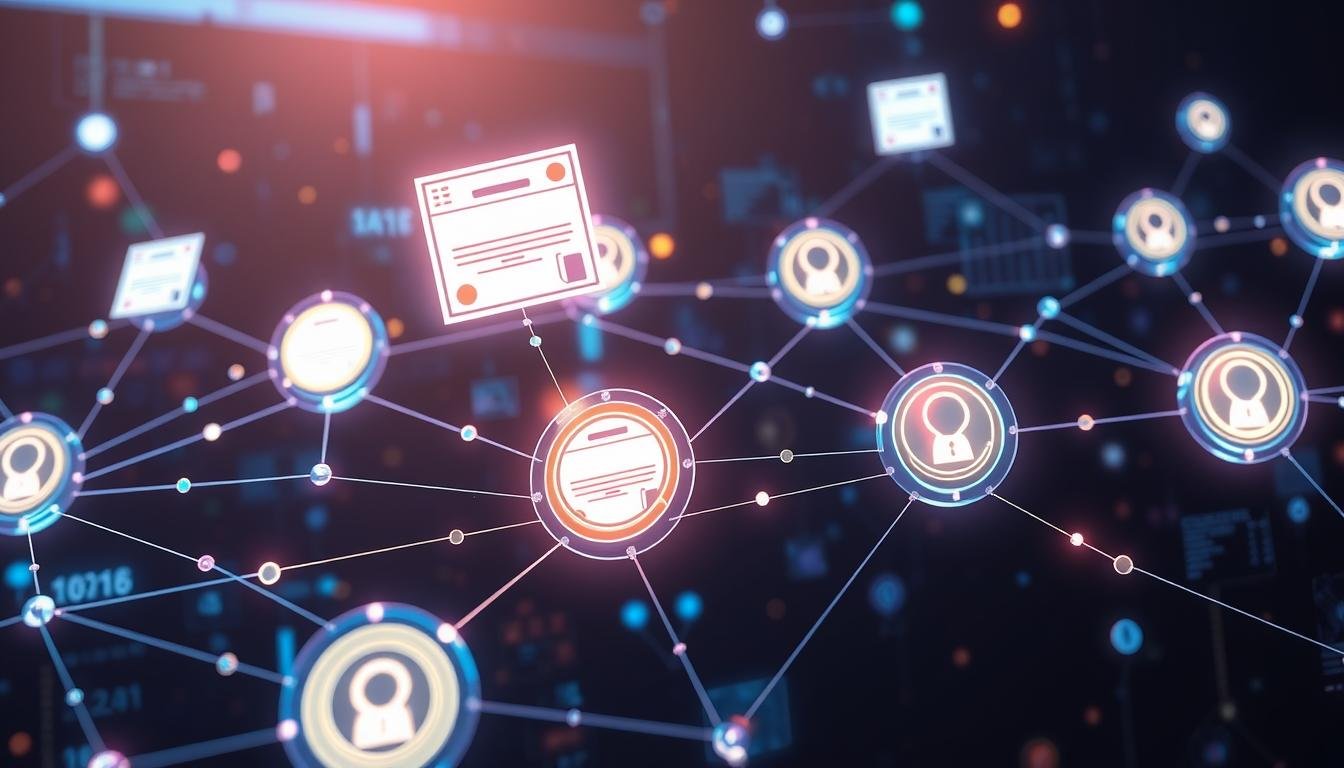Blockchain in Education: Verifiable Credentials
In today’s digital world, our important documents are moving from paper to digital. This includes identity cards and academic degrees. But, there’s a big challenge in this shift: making sure these digital documents are real and can’t be changed.
This is where “verifiable credentials” (VCs) come in. They are digital versions of important documents, issued by trusted sources. They are stored on a blockchain, which makes sure the information is safe, can be checked, and can’t be altered.
Key Takeaways
- Verifiable Credentials (VCs) are digital equivalents of physical credentials, ensuring authenticity and security.
- Blockchain technology plays a crucial role in the security and immutability of digital credentials.
- VCs adhere to standards set by the World Wide Web Consortium (W3C) for secure and trusted digital credentialing.
- Decentralized Identifiers (DIDs) serve as secure identifiers for users in the VC ecosystem.
- The global blockchain in education market is expected to grow significantly, driven by the adoption of blockchain-based credentialing.
The Rise of Verifiable Credentials and Their Significance
In today’s digital world, we need secure and verifiable credentials more than ever. As more documents go digital, old paper systems are no longer safe from fraud. Verifiable Credentials (VCs) offer a way to keep digital info safe and true.
Digitizing Documents: The Need for VCs
Going digital has changed how we handle and share info. But it’s also raised new worries about the safety and trustworthiness of digital stuff. Verifiable Credentials help by making sure digital documents like school records and work permits are real and can’t be changed without permission.
The Role of Blockchain in VCs
Blockchain technology is key to Verifiable Credentials. It’s a system that keeps records safe and unchanged. This means Verifiable Credentials can be trusted and shared safely, building trust in the digital world.
The Parties Involved in Verifiable Credentials
The Verifiable Credential world has three main players:
- Issuer: This is who gives out Verifiable Credentials, like schools or government offices.
- Holder: This is the person or group that has the Verifiable Credential and decides who to share it with.
- Verifier: This is who checks if the Verifiable Credential is real and valid.
For Verifiable Credentials to work well, these groups need to trust and work together smoothly.
Blockchain in Education: Verifiable Credentials
Traditional Challenges in Credential Verification
Checking academic credentials used to be hard and slow. It meant calling schools, checking records by hand, and making sure they were real. This whole process could take a long time, causing delays for students.
Also, relying on one place for all records made it easy for mistakes and fraud to happen.
Blockchain’s Solution to Credential Verification
Blockchain changes how we check credentials. It uses a secure, shared ledger to store and check academic records fast. Each record gets a special code that proves it’s real and can’t be changed.
This makes checking credentials quick and easy. It also stops Academic Credentials on Blockchain from being tampered with. It gives a permanent, safe record of Trustless Verification of Achievements.
Blockchain helps share and check educational experiences and qualifications worldwide. It makes it easier for people to move and work globally. This technology creates a new way to trust Tamper-proof Transcripts, changing how we see academic achievements.
“Blockchain technology enables instant and highly certain validation of claims about individuals or institutions, eliminating records fraud in the educational sector.”
The COVID-19 crisis showed us how important quick and safe digital data sharing is. Blockchain-based credentialing is key for fast and trustworthy sharing of academic records. It helps both students and schools.
Real-World Applications and Case Studies
Blockchain technology is changing many industries, including education. Schools are now using blockchain for secure and easy verification. Let’s look at how Blockchain-based Diplomas, Tamper-proof Transcripts, and Trustless Verification of Achievements are making a difference.
MIT Media Lab — Blockcerts
The MIT Media Lab leads in using blockchain for credentials with Blockcerts. This program lets graduates have a secure, tamper-proof copy of their credentials. They can easily share their achievements with employers or schools.
University of Melbourne
The University of Melbourne was the first in Australia to use blockchain for digital credentials. This move has made credential verification faster and more accurate. It has also made academic records more reliable.
Sony Global Education — Open Blockchain Platform
Sony Global Education created a blockchain platform for educational records. This platform cuts down fraud risk and makes academic records more reliable. It offers a secure and trustless verification of achievements.
ECPI University — Digital Diplomas
ECPI University in Virginia, USA, teamed up with Learning Machine to issue digital diplomas on blockchain. This makes it simpler for graduates to share their credentials. It ensures a tamper-proof record of their achievements.
These examples show how blockchain is changing education. It makes verifying credentials secure and efficient. It also reduces fraud risk and lets people own their academic achievements.
The Impact of Blockchain on Credential Verification
Blockchain technology is changing how we verify credentials in education. It helps fight academic fraud by making academic records more secure and reliable.
Fraud Reduction
Blockchain creates Immutable Academic Records and Tamper-proof Transcripts. This can cut down fraud by up to 75%, says the Council for Higher Education Accreditation (CHEA). It’s hard to change these records because of blockchain’s decentralized nature.
Efficiency Gains
Blockchain also makes things more efficient. IBM found it can speed up verification by up to 80%. This saves money and time for everyone involved.
It makes the student experience better and helps schools focus on teaching.
Global Adoption
More and more schools are using blockchain for credentials. A 2022 survey by HolonIQ shows over 50% of schools will use it by 2025. This shows blockchain’s big impact on education.
“Blockchain technology promises to revolutionize higher education institutions (HEIs) by refocusing their mission on teaching.”
Conclusion
Blockchain technology is changing how we verify academic credentials. It makes the process secure, efficient, and tamper-proof. Schools like MIT, the University of Melbourne, and Sony Global Education show its benefits.
These benefits include less fraud, better efficiency, and more reliable records. As more schools use blockchain, the education world will keep getting better. This will help students, teachers, and employers.
The future of blockchain in education looks promising. It could make managing educational records easier and more trustworthy. By using blockchain, schools can protect academic credentials better. This creates a safer and more reliable place for learning.
Source Links
- Securing Documents with Blockchain VCs
- BLOCKCHAIN IN EDUCATION: REVOLUTIONIZING ACADEMIC VERIFICATION AND RESOURCE ACCESS
- Revolutionizing Education: The Power of Blockchain for Verifiable Credentials | VerifyEd
- Verifiable Credentials: The Ultimate Guide 2024
- The Future of Verifiable Credentials in Education
- Blockchain and AI in Education: Revolutionizing Credential Verification and Personalized Learning
- Blockchain Credentialing For Educational Institutions
- Blockchain Applications & Case Studies (An Overview)
- Blockchain Case Studies: Verifiable credentials/Digital Identity
- The Catalyzing Impact of Blockchain Technology on Higher Education – The EvoLLLution
- Development of Blockchain-Based Academic Credential Verification System
- Blockchain in Education: Revolutionizing Credential Verification and Academic Records
- Blockchain in Education: Verifying Credentials and Beyond
- An In-Depth Look at the Top Blockchain Education Innovations






